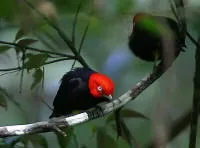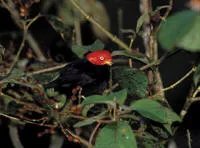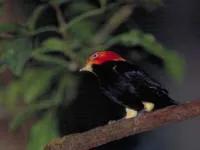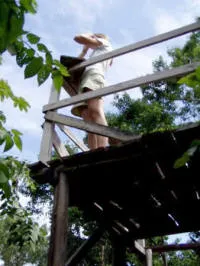Bird Watching in Costa Rica
The Dance of the Red-capped Manakin
By Jack Ewing

For the uninitiated, a bird watcher’s enthusiasm for hearing, sighting and studying our feathered friends, is hard to fathom. Why would anyone rise with the sun, walk for hours while toting binoculars, spotting scope, tripod, field guide, check list and notebook just to observe something so mundane as a bird? We all see birds every day, so what’s the big deal? Hard-core bird watchers have even been the brunt of jokes and cartoons. One of my favorites is a Gary Larson Far Side Cartoon with a view through a pair of binoculars, showing a large nasty looking bird sitting in an equally large nest, staring evilly at the observer — the person looking through the binoculars. Dangling from the edge of the nest are several pairs of binoculars, a birder’s hat and a tote bag with a Field Guide to the Birds of America. No caption was necessary.
Seriously though, bird watching is big business, and Costa Rica is a hot spot for birders. To begin, it is located in the tropics, a warm hospitable climate, midway between the North and South American continents. Migrants from both may find a warm haven during their respective winters. It also has coastline on two oceans. In altitude Costa Rica’s terrain ranges from sea level to nearly 4000 meters (13,000 feet,) well above timberline. In the tropics, a slight change in altitude brings a corresponding change in climate. There are more than 20 micro-climates in Costa Rica, and A Guide to the Birds of Costa Rica by F. Gary Stiles and Alexander F. Skutch, list 20 distinct habitats found in the country. Because of this diversity of environmental conditions and factors, Costa Rica is host to over 830 species of birds, more than the United States and Canada combined. Another excellen book is The Birds of Costa Rica: A Field Guide
As any ecotourism establishment well knows, bird watching enthusiasts come from every part of the world. I remember an afternoon in January of 2004 when all six of Hacienda Barú’s cabins were rented to bird watchers from as many different countries. Prior to setting out for their late afternoon birding hikes, everyone had congregated in the garden to compare notes and checklists. Spotting scopes, field guides, cameras and binoculars surrounded the tables where the aficionados were gathered. The enthusiasm was contagious as people from Costa Rica, United States, Canada, Germany, Spain, and England talked excitedly about the one thing they all had in common, an intense interest in birds.

I have long admired British bird watchers. This is partly because their approach to birding is so methodical, but also because my first birding experience with experts was with a British couple named Roger and Sharon. The experience took place in the late 1980’s when we had just begun to cater to ecotourism at Hacienda Barú. The couple stopped by one afternoon and scheduled a hiking tour called “The Rainforest Experience” for the next day. When I told them that they would see many more birds in the lowlands on the “Mangrove Walk,” Roger agreed, but said the birds would probably be ones they had already logged during their two weeks in Costa Rica. What they wanted to see were the rainforest birds, fewer species in a habitat with limited visibility and unlimited hiding places. We scheduled the “Rainforest Experience” for the next morning, before daybreak. Little did I suspect that within 24 hours I would be afflicted with bird watching fever; that I would return from the hike a full-fledged addict.
We made it to the rainforest campsite about the same time as the first crimson rays of sunlight filtered through the rainforest canopy. Over a breakfast of coffee and sweet rolls we listened to a cacophony of jungle wake-up sounds, hundreds of creatures struggling to make themselves heard. No small portion of the calls came from birds. Roger would cock a thoughtful ear to one side for a moment or two and pronounce the name of the bird that had made the sound. The most interesting sighting at the jungle camp was a pair of Mealy Parrots, large impressive birds that squawked outrageously for the duration of breakfast. It was a first for me, but Roger and Sharon had already logged it elsewhere. Preparing to set out through the forest, Roger described the type of habitat they were looking for, areas with thick under story and vine growth. Antbirds and manakins were what they really hoped to see. I pretended to know what they were talking about.
Roger’s highly trained eyes and ears picked up many birds that I missed. I saw all the toucans, motmots and big red headed woodpeckers, but those didn’t seem to impress my clients. Instead they seemed more excited about some of the little birds that I tended to dump into the single category of “little brown jobs” or “LBJ’s.” But, as I listened to Roger and Sharon, their enthusiasm captivated me. My education was only beginning.
Within an hour after leaving camp we began hearing calls from several distinct bird species. The sounds all seemed to be coming from the same general area. As we approached, the volume and number of different calls increased.

“This is a birder’s dream,” said Roger, smiling. “Certain species of birds have learned to look for any sort of commotion that disturbs the insects and small invertebrates. They hang out nearby and grab everything that flies, hops or runs from the source of the commotion. Sometimes they follow monkeys, but marauding army ants cause more havoc.”
Carnivorous army ants hunt by fanning out as they march through the jungle like a battalion of soldiers. They try to surround, capture and eat everything in their path. When army ants are on the prowl, general panic ensues in the animal world. Insects, beetles, lizards and small mammals flee for their lives. A number of different bird species have learned to take advantage of this general panic by hanging out around the edges of the ant mass and picking off all the small animal life that escapes. Upwards of 20 species of birds may participate in a mixed feeding flock, each one with its own specialty.
The first one we saw was a Chestnut-backed Antbird as it scurried around on the ground at the edge of the ants, snapping up beetles and roaches that bolted from beneath sticks and rocks. Another ground feeder, the Scaly-throated Leaftosser, was more aggressive, tossing fallen leaves left and right and snatching what hid beneath. A pair of Buff-throated Foliage-gleaners searched the lower branches and leaves of bushes for insects, occasionally dropping to the ground to rummage in leaf litter. A little higher in the foliage Sharon spotted a Black-hooded Antshrike flitting through the under story, snaring an occasional insect. Higher still was a Russet Antshrike pulling apart a cluster of leaves, probing for whatever morsel might be shrouded inside. A Tawny-winged Woodcreeper grabbed a fleeing spider that scampered up a tree trunk ahead of a fan of army ants. Higher up on a neighboring tree was a Buff-throated Woodcreeper searching every crack and crevice, always hopping up the trunk, never down. A pair of White-throated Shrike-Tanagers were catching insects on the wing, flying out from a perch in short sallies. A Black-throated Trogon was hungrily gobbling down larger insects such as katydids and cicadas, and a Double-toothed Kite was hunting everything that moved. A Chestnut-mandibled Toucan was even hanging out in the crown of a large tree, waiting for any opportunity. We identified 18 different species, five of which were new for Roger and Sharon and eleven for me, although I am sure there were more. Roger pointed out that each species was represented by no more than one pair. Any new species was welcome to enter the group, because it would stick to its own specialty and not compete with the others. Every species took advantage of one niche or place where its prey might be found, but didn’t interfere with other species. However, if another member of a species already present in the flock tried to join, it would be soundly rebuffed by its own kin. The resident would defend the niche against intruders, and the only likely competitors would be members of its own species. We hiked on through the forest totally vitalized by the experience.
We passed through an area where the under story seemed denser and the vine growth thicker. I heard a loud snapping sound but couldn’t imagine what might be making it. As we got closer, I noticed that the “snap” was preceded by a “buzz.” Ever more curious I carefully scanned the surrounding foliage for the source of this strange disturbance. I spotted the Manakins almost at the same time as Roger.
“Unbelievable! Absolutely amazing! I have never seen this,” he whispered. “This must be the mating dance of Pipra mentalis, the Red-capped Manakin. Brilliant!”

The setting was as perfect as a carefully set stage arranged precisely for the actors that were performing in this pristine theater. At center stage sat the dull, light-greenish, rather nondescript female, preening herself while four suitors took turns competing for her favor. Her throne was a small twig. Four longer branches, each coming from a different direction, extended inward toward the princess, with one aspiring beau on each. One by one each of the males danced the length of his branch, starting on the far end with his bright red head bobbing, his vibrant orange thighs and yellow legs in a flurry of movement, carrying his coal black body the length of his branch to within a few centimeters of his lady love. At this point he emitted a loud “buzz,” leaped into the air and made the loud “snap” that had attracted me to the scene. The “snap” was so quick that it was impossible to discern how he produced it. I remember thinking that it might be by clapping the wings together, but then discarded that possibility thinking that the force necessary to make such a loud “snap” would certainly break wing bones. The fervent suitor repeated his dance in an outward direction finishing with another buzz and snap. Then he waited quietly, the perfect gentleman, while his rivals made their bids. During the entire performance, the object of all this attention, the lady in waiting, appeared not to realize that she was the big attraction, and totally ignored all four aspirants. After each proud performer had received two or three opportunities, the seemingly unimpressed female stopped preening herself, sat up, looked around and flew away. The four males looked at each other, totally dumfounded, jumped into the air and flew after her. I couldn’t help but chuckle.
Roger explained that the stage for this incredible mating game is called a lek. A Guide to the Birds of Costa Rica confirmed that the loud “snap” was, indeed, produced by slapping the wings together. Each species of manakin has a slightly different version of the dance. Though four other species of manakin are found on Hacienda Barú, Blue-crowned Manakin, White-ruffed Manakin, Orange-collared Manakin and Thrushlike Manakin, even Roger admitted he couldn’t tell the females apart. The males, however, are quite distinct. With the exception of the Thrushlike manakin, all of these forest denizens have leks and ritual dances, and make a high pitched peep each time they jump up into the air from their perch. In Spanish their common names tend to suggest jumping or dancing, “saltarin” or “bailarin”. They are all small and beautiful, but none quite so charming as my redheaded favorite.
Though we sighted several more birds, the walk home was uneventful in comparison to the spectacles we had already witnessed. Though I was supposed to be the guide, in all honesty, I did little more than keep us from getting lost. Roger and Sharon were the experts, and they graciously shared their knowledge as well as their enthusiasm. Never again would I wonder at the fervency of the typical bird watcher. That day was my initiation into a new world.
Bird watching means more to me than the excitement and satisfaction that comes from the pursuit and identification of avian species. I firmly believe that the conservation and regeneration of the rainforest is of utmost importance for the future of our planet. I also believe that the only that way conservation will work is to make it profitable. There simply aren’t enough philanthropists in the world with enough money to save these critical natural environments. If however, we can find ways to make a living from intact rainforests, without harming them, we will have a built-in incentive to protect them. Responsible ecotourism is a proven method for doing this. Without ecotourism we could not afford to protect Hacienda Barú National Wildlife Refuge and maintain it in its natural state. Bird watching is a very special kind of ecotourism that accounts for a large percentage of our visitors. Give it a try. But be careful, it’s addictive.
Editor’s Note: Hacienda Barú is a wonderful destination for birders or anyone interested in the wonder of Costa Rica. Built and run by renowned naturalist and ecologist (and contributor) Jack Ewing, we highly recommend a visit!
© Jack Ewing – Republished in The Real Costa Rica with permission
** My wife and I visited a birdwatchers paradise. If you are interested, the story appears in our BLOG. There are two parts. To begin, Click here.
Email this page to a friend









